Well, okay, perhaps things weren't that extreme, but it's been a while since I've posted. Christmas, the whirlwind of the Cub's stay, plus the usual start-of-semester madness has pretty much put the kibosh on both painting and playing. Add in the sense of doldrums I was dealing with a few weeks back, and frankly, not much went on in Monkeyland over the last three weeks or so.
That said, I did get down to the Dueling Grounds last night for a fun night of gaming and catching up. I got in two games of Magic in the Commander format against Otherdave (the format, fyi, is insanely fun), and a 400 point game of Muskets and Tomahawks against Vonplutz. I think I'll save commander for a separate post (maybe this weekend), but I thought I'd post a batrep from the game with VP to get things going again at the blog.
First off, one thing I did do over the holidays was rebase the figures I'd already painted using steel washers. I'd been using pennies, and while they're cheap and serviceable, transportation had been giving me problems.

I used some double sided tape to line the bottom of an old toolbox with some magnetic sheeting, and now the figures stick to the box no problem. No shifting, no need to pad, just stick them in the box and go. In a pinch, I can remove the sheeting to bare the steel, and still use the box for magnetized bases (like my Impetus armies). Easy peasy.
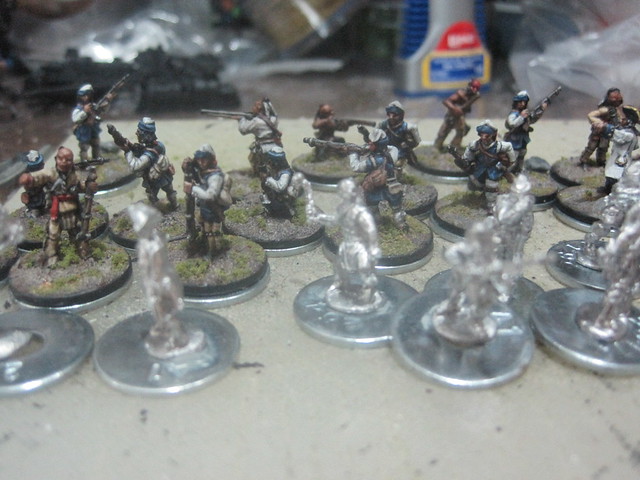
I'll probably do the same for my Bolt Action stuff as well. Watts at the THMG did something similar with his (although, with a much nicer box), and it seemed like a solid idea. Huzzah for hobby networking ;)
With my dandy new box in tow, I set out to give Vonplutz's British a thrashing. We determined objectives (he had Raid, I had Engagement), set up terrain, I deployed, he deployed, and away we went.

There's a lot of nice subtlety in the game mechanics for M&T, little things like how determining deployment order works. Each player has a force type, determined by the dominant class of troops in their force. Mine, composed of Compagnie Franche de la Marine with some Native allies, is Irregular. VP's composed of mostly British Line with some provincial rangers and militia, is Regular. While objectives are determined randomly, different force types are predisposed more to some missions / objectives than others. Objectives are also ordered by number, with the more aggressive missions having a higher number. Lower number deploys first. I had to play a few times before I got it, but the net effect is that forces more likely to assume a defensive role, or be involved in set-piece fighting, are more likely to get objectives of that kind, and deploy as defenders before the aggressive / mobile / raider forces. It's a nice touch, and the game is full of them.
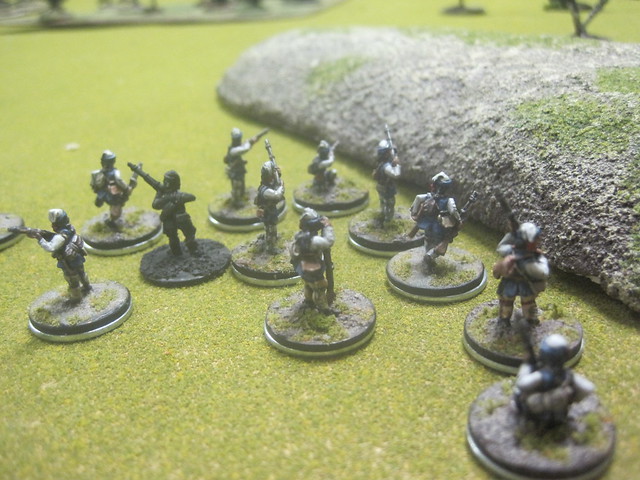
As is happens, however, the usual roles were reversed. VP's regulars with their provincial escort had set out to burn a French settlement, and my flying column of marines and Hurons were racing to head them off before they could. It would prove to be a tense and bloody confrontation.
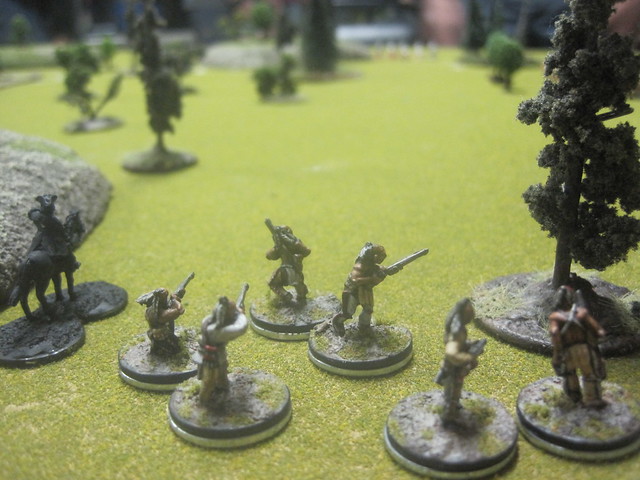
I deployed one of my marine squads behind the little village. Their job would be to move up, take shelter in the houses, and hold off the British raiders as long as they could.
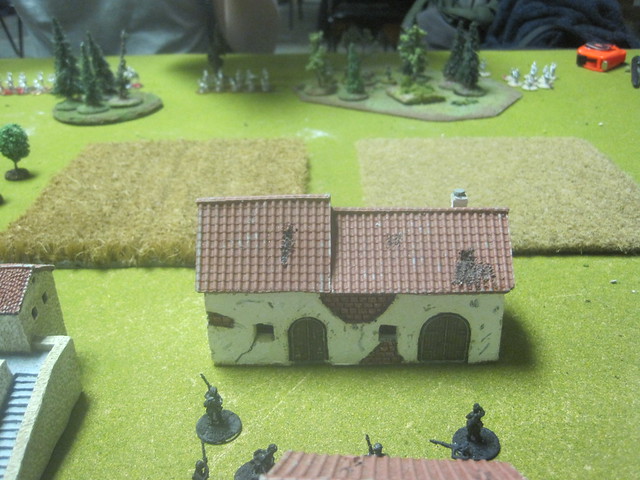
Meanwhile, the other marine unit, and both units of allies, would work their way around the flank, and try to harry the British as they closed on their own objective. I encountered the effect of regular musketry in firing line the last time I played M&T, and while it's been a while, I have a healthy respect for it's destructive potential. I wasn't going to get into a head-on fight if I could avoid it.
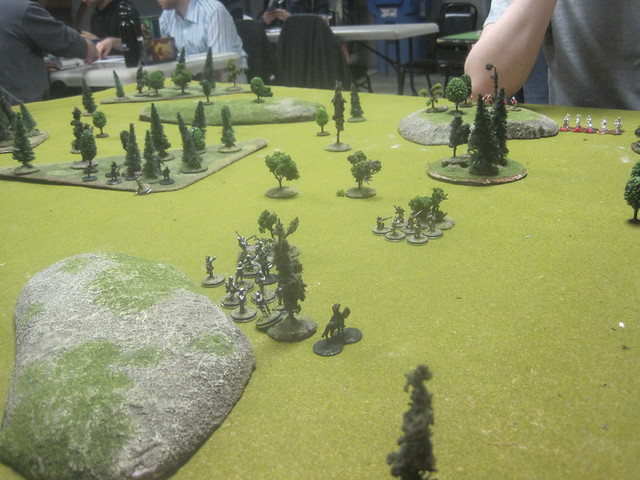
VP, for his part, set his regulars to march straight for the French settlement, with his irregulars thrown out as flankers.

In the first turn it seemed like the French cards were all top deck (M&T works on a card activation system; each card indicates a unit type, and the number of actions it can take). My flanking forces quickly advanced, and I pushed my Huron allies (Allies is a unit trait that can be purchased; it means that the native unit can benefit from the proximity of a French officer) toward the cover of a small copse of woods covering the approach to the village. In retrospect, given that I'd paid for rifles, and my Hurons would have been almost as effective from back on my edge, this may have been a mistake.
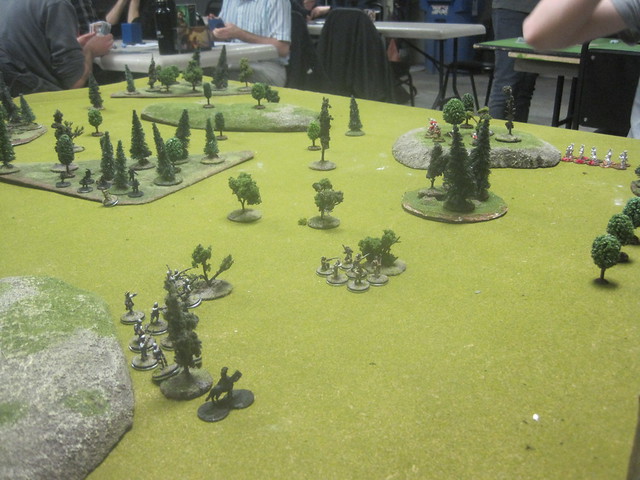

When VP finally started drawing some British cards, withering fire from his irregulars drove my Huron allies out of the woods in full flight (it would take a full turn before they'd recover and rejoin the battle). In the meantime, his regulars stolidly marched towards the village, peppering the buildings with musket fire.
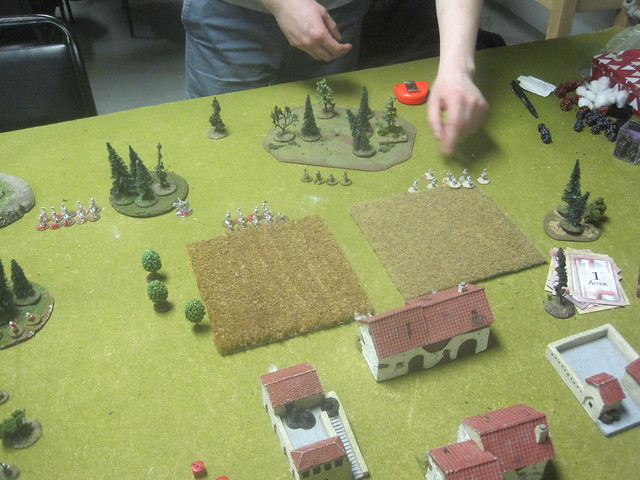
At this point in the game, I was actually quite concerned. VP had seized a key piece of covering terrain, had two units closing on the objective, and stood an excellent chance of holding me off long enough to fire the buildings.
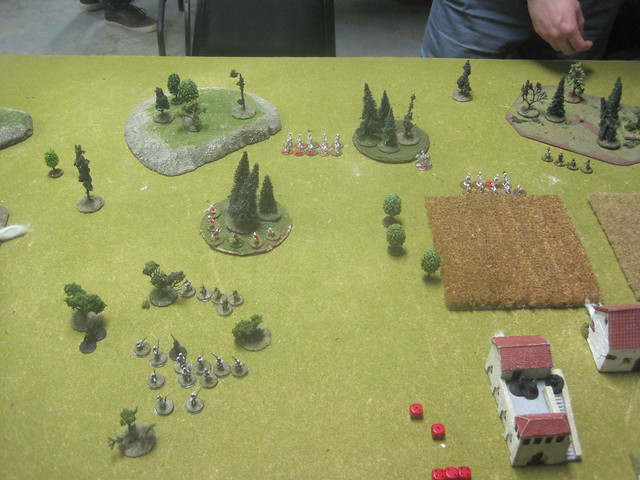
While I tried to organize something on my left, VP continued to pour fire into the building with a unit of regulars and a unit of his provincials, and brought up the second unit of regulars to help block my flanking attack. Thankfully, the stout walls of the French buildings gave my marines good cover, and they weathered the worst of the British fire with aplomb.
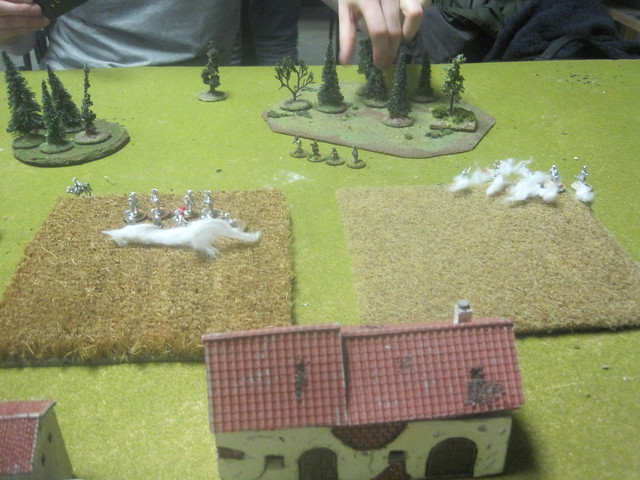

Thins went from bad to worse when VP drew some early cards on his next turn, fired into my already shaken Hurons, and convinced them to keep running. My marines had managed to shake out a decent line by this point, however, and while the British provincials occupied themselves with the Hurons, my marines got in the chump shot on the advancing regulars, killing several.
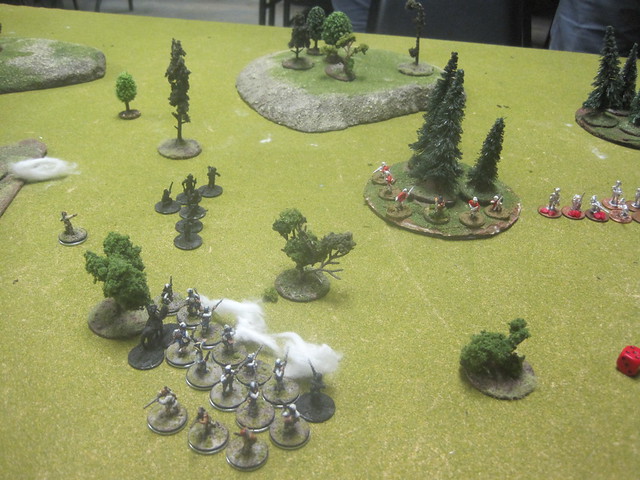
While the British held, I'd done enough damage to get an edge on the attrition game, and had moved up my second unit of natives to within charging distance of the provincials in the woods. These were Sauk and Fox, from the hinterland, and while they're not as handy with a musket, they're pure murder in close combat.
Meanwhile, back at the village, VP decided to send his men in. With a roar and fixed bayonets, the British regulars charged the foremost building, and a bloody skirmish broke out, cut and thrust through windows and the burst doors of the house. Combat in M&T is bloody and can be decisive. You keep fighting until someone's reaction test causes them to flee, and fleeing generally results in more casualties. By the time the fighting was done, I'd lost about half my marines, but the British regulars were broken; only one man limped away from the fight.
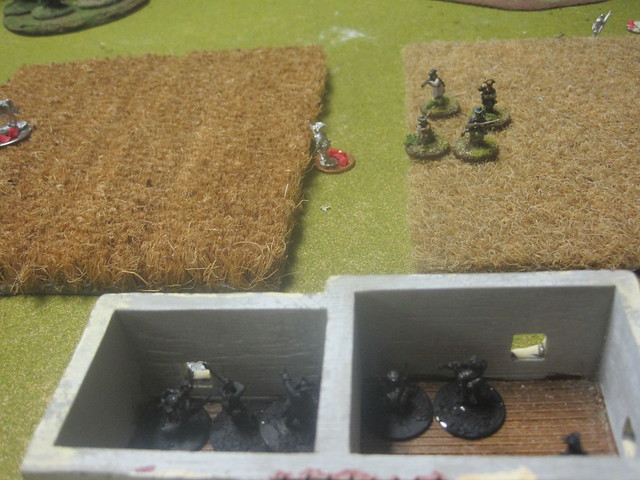
The victorious marines then sent a volley into the American militia that had been creeping up in the shadow of the British. They killed one, and the rest took to their heels.

On the left, things were swinging my way as well. My marines were winning the battle of attrition against the regulars. VP got a volley off against the natives moving up, but only managed to kill one, and the rest closed in. With their blood up, they chased the provincials down, and killed them to the last man. A second card activation then sent them into the already reduced unit of regulars, who decided that all the drill in the world hadn't prepared them for a knife fight in the woods. The remnants of the regulars took to their heels, and all of a sudden, VP's flank was open.
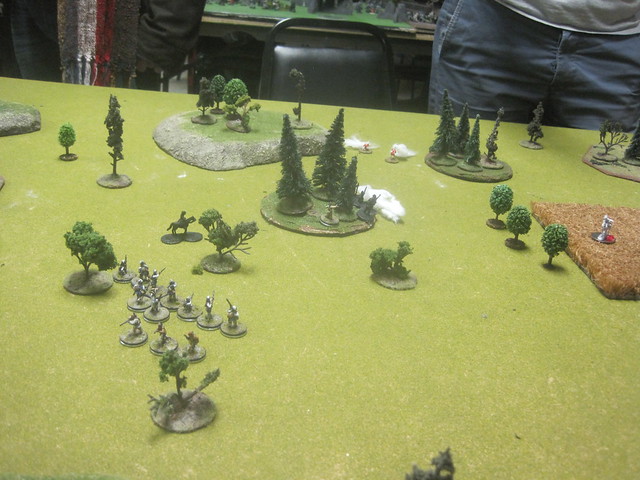
Although he still had a unit of provincials in play, VP had yet to set fire to any of the buildings, and I only needed to cause three more casualties to win. With time getting short in the evening, we decided to call the game.
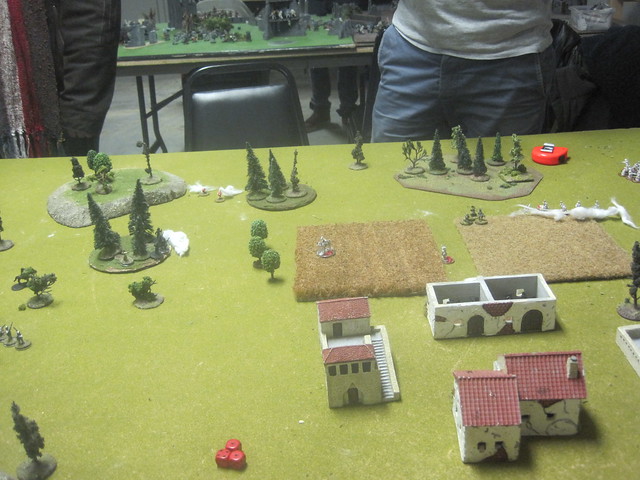
This was a terrific game. The activation mechanics in the game create a real sense of tension. There was a point where VP had dominated activation in the bottom half of one turn, and the top of the next. He was putting real pressure on me, and I was definitely on the back foot. But then, of course, the tempo swung my way, and with mostly French cards left to draw, was able to hit him again and again with only a limited opportunity for him to react. Despite the advantages my men in the buildings had, the fight there was touch and go, so the timing of winning the battle for the house, and then sweeping in on the flank, made this feel like a terrific come-from-behind win.
I'd forgotten how much I enjoyed this game. 400 points took us 2 1/2 hours from set up to clean up, and that was with plenty of rule-perusing and "how do we do that again?" thrown into the mix. Painting up a second 200 points of this is going to be a priority, I think, and I'm sure VP will be up for a rematch.
FMB

I sure am up for it. The fresh officer from England has learned much from his first engagement so we shall see how it goes next time.
ReplyDeleteGood work men. I can only hope that VP will return to give the dastardly French what for!
ReplyDeleteGood to see you back and a good game too!
ReplyDeleteExcellent looking game. I want to get a game of M&T this year!
ReplyDeleteGreat battle report. I love the M&T rules. They flow well and are intuitive. I have a blog focused on M&T.
ReplyDeletehttp://tomahawkcampaign.blogspot.com
This looks like a blast...I've got to give these rules a go. The siren song is loud and drawing me closer.
ReplyDeleteAll the cool kids are doing it Monty ;)
DeleteIt seems like you're making up for your time away from the Hobby. Good to have you back.
ReplyDeleteLove that picture-one of my favourite movies. And one of my favourite lines is when Madeline Kahn says, when talking about Dr. Frankenstein, "He is my boyfriend!"
It seems like you're making up for your time away from the Hobby. Good to have you back.
ReplyDeleteLove that picture-one of my favourite movies. And one of my favourite lines is when Madeline Kahn says, when talking about Dr. Frankenstein, "He is my boyfriend!"
Yeah, it's a favourite of mine as well, Anne. Brilliant :)
DeleteLooks pretty cool!!!!
ReplyDeleteNicely done, beautiful table and buildings...great looking game!
ReplyDelete